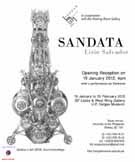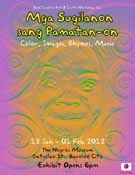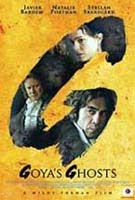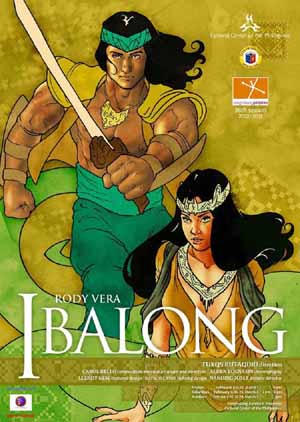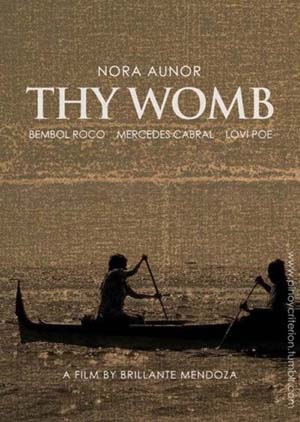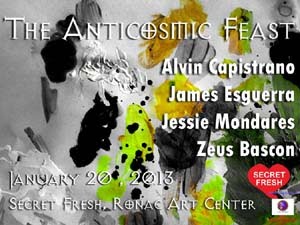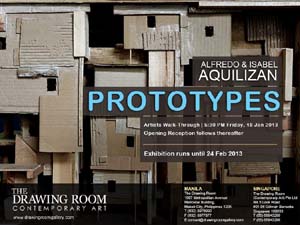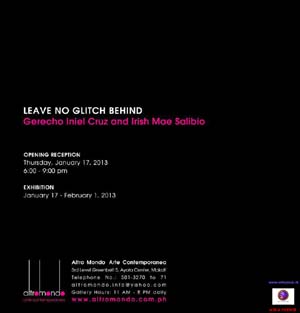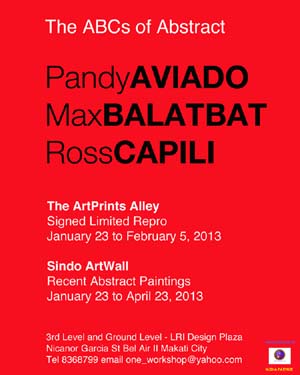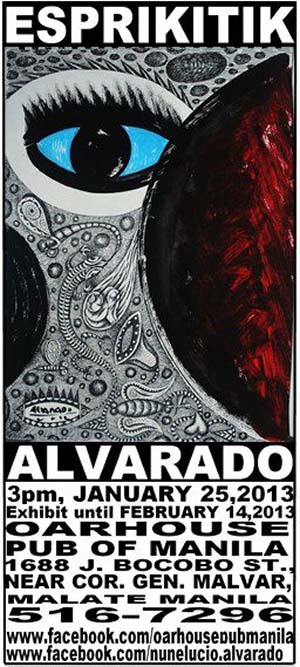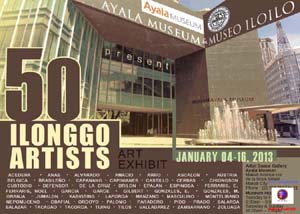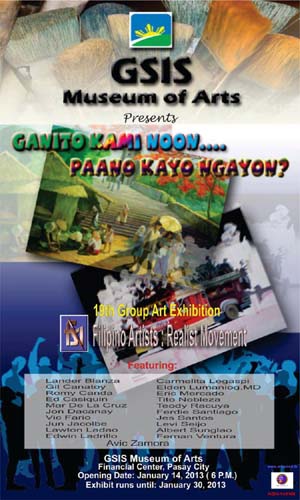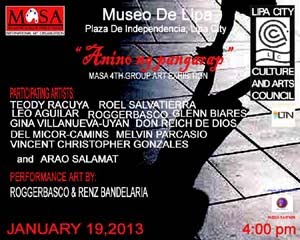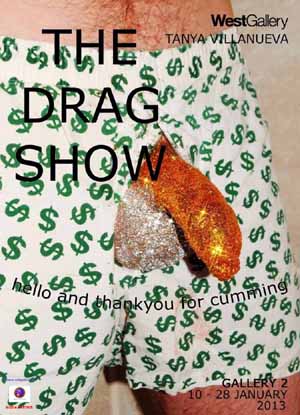
RISING FROM THE ASHES: Dennis Montera’s Aftermath
by Reuben Ramas Cañete, Ph.D.
Catharsis has always been the lodestone by which Dennis “Sio” Montera produces his distinctive form of Filipino Abstraction. The Cebu City-based MFA graduate of UP Diliman, and faculty member of UP College Cebu, utilizes an opposition between acrylic-based media and brilliantly-coloured paints with black bitumen tar, a medium more known for paving roads and sealing gutters than for painting canvas panels. And yet, such an unlikely approach to material is not entirely against the Modernist grain: the black paintings of Ad Reinhardt and Frank Stella in the 1950s also used tar in order to exploit their intense tonality of black, as well as the reflective, sometimes opalescent sheen that the oils of the tar excrete from reflecting light. The material integrity of oil and acrylic (provided that the first lies on top of the second) is also proven from those paintings by Jackson Pollock and Willem de Kooning dating back to the 1940s—but all of this, of course, should not be an issue to those who see in Montera’s paintings as not an ambivalent conflict between water-based and oil-based media, but rather in the vision of elemental—and thus metaphorical—conflict resolved into significant form. As far back as 2004, when Montera finished his first
magnum opus, Penitensiya, both the use of media as well as the concept of an epic conflict to be resolved was already transmitted through his meditation of penitential labour as a peculiarly Filipino aesthetic form of psychic as well as social redemption.
In his 2009 series Aftermath, Montera utilizes the near-catastrophes and lucky breaks that he has experienced in his personal life over the past year as the aesthetic source of his catharsis: his wife’s difficult ectopic pregnancy, as well as his mother’s bout with kidney cancer, that tested both his emotional and financial strength, and eventually managed to resolve these crises successfully. The return of normal life in the Montera household was the chance for Sio to meditate on the fragility of existence, and realize that “life held no guarantees.” Liberated from a sense of deliberation, Sio eviscerate his painting style into a freer and more spontaneous fragmentation of motif. Gone were the long loops, spatially-delimited blocks, and carefully-laid diagonal drips that characterized his 2006-2008 paintings, and in turn the “open forms” of randomly intersecting circular splashes and thrown drips, the freer colour brushwork, and the emphasis on entropy rather than structure became dominant elements in his new work. The results also imply a more energetic restlessness and unwillingness to compromise on his artistic convictions.
This transition can be seen in The Beginnings of Panic, where the previous tendency to “block out” colour and black elements begins to fray, as the compositional blocks float amidst flying debris of painted texture and black, like asteroids smashing against each other in the colourful void of a nebula. Newfound Rapture is the resolution of such a “crisis,” where the compositional placements of underlying aquamarine, magenta, and white acrylic painted blocks are reworked repeatedly to form a dense base, looking rather like fantastic cave wall formations, upon which the black tar is then flung as a foreground element, becoming like trace patterns of bats flying in neon-inflected space. In The Vicissitudes of the Seasons, Sio summarizes his past year’s life as one of order interspersed with chaos, and resolved with order: the base colour blocks that march in horizontal regularity are layered with a vertical frenzy of gestural texture, and then is finished with an uneven grid of black lines. Aftermath may be the account of one artist whose life went briefly to hell and back, but Dennis “Sio” Montera also provides us with the comfort that every catastrophe is also an opportunity to learn and grow. Indeed, Sio’s “aftermath” also proves his aesthetic capacity to resolve crisis with a cathartic renewal, a phoenix of work that rises from the ashes of despair.
by Reuben Ramas Cañete, Ph.D.
Catharsis has always been the lodestone by which Dennis “Sio” Montera produces his distinctive form of Filipino Abstraction. The Cebu City-based MFA graduate of UP Diliman, and faculty member of UP College Cebu, utilizes an opposition between acrylic-based media and brilliantly-coloured paints with black bitumen tar, a medium more known for paving roads and sealing gutters than for painting canvas panels. And yet, such an unlikely approach to material is not entirely against the Modernist grain: the black paintings of Ad Reinhardt and Frank Stella in the 1950s also used tar in order to exploit their intense tonality of black, as well as the reflective, sometimes opalescent sheen that the oils of the tar excrete from reflecting light. The material integrity of oil and acrylic (provided that the first lies on top of the second) is also proven from those paintings by Jackson Pollock and Willem de Kooning dating back to the 1940s—but all of this, of course, should not be an issue to those who see in Montera’s paintings as not an ambivalent conflict between water-based and oil-based media, but rather in the vision of elemental—and thus metaphorical—conflict resolved into significant form. As far back as 2004, when Montera finished his first
magnum opus, Penitensiya, both the use of media as well as the concept of an epic conflict to be resolved was already transmitted through his meditation of penitential labour as a peculiarly Filipino aesthetic form of psychic as well as social redemption.
In his 2009 series Aftermath, Montera utilizes the near-catastrophes and lucky breaks that he has experienced in his personal life over the past year as the aesthetic source of his catharsis: his wife’s difficult ectopic pregnancy, as well as his mother’s bout with kidney cancer, that tested both his emotional and financial strength, and eventually managed to resolve these crises successfully. The return of normal life in the Montera household was the chance for Sio to meditate on the fragility of existence, and realize that “life held no guarantees.” Liberated from a sense of deliberation, Sio eviscerate his painting style into a freer and more spontaneous fragmentation of motif. Gone were the long loops, spatially-delimited blocks, and carefully-laid diagonal drips that characterized his 2006-2008 paintings, and in turn the “open forms” of randomly intersecting circular splashes and thrown drips, the freer colour brushwork, and the emphasis on entropy rather than structure became dominant elements in his new work. The results also imply a more energetic restlessness and unwillingness to compromise on his artistic convictions.
This transition can be seen in The Beginnings of Panic, where the previous tendency to “block out” colour and black elements begins to fray, as the compositional blocks float amidst flying debris of painted texture and black, like asteroids smashing against each other in the colourful void of a nebula. Newfound Rapture is the resolution of such a “crisis,” where the compositional placements of underlying aquamarine, magenta, and white acrylic painted blocks are reworked repeatedly to form a dense base, looking rather like fantastic cave wall formations, upon which the black tar is then flung as a foreground element, becoming like trace patterns of bats flying in neon-inflected space. In The Vicissitudes of the Seasons, Sio summarizes his past year’s life as one of order interspersed with chaos, and resolved with order: the base colour blocks that march in horizontal regularity are layered with a vertical frenzy of gestural texture, and then is finished with an uneven grid of black lines. Aftermath may be the account of one artist whose life went briefly to hell and back, but Dennis “Sio” Montera also provides us with the comfort that every catastrophe is also an opportunity to learn and grow. Indeed, Sio’s “aftermath” also proves his aesthetic capacity to resolve crisis with a cathartic renewal, a phoenix of work that rises from the ashes of despair.





























































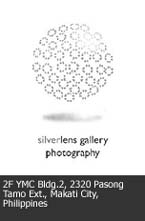











































.JPG)
.JPG)











.JPG)



















.JPG)





.JPG)






